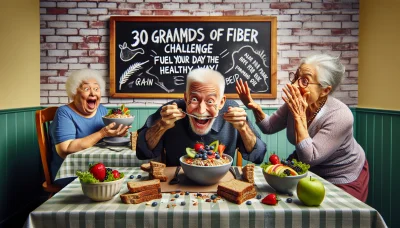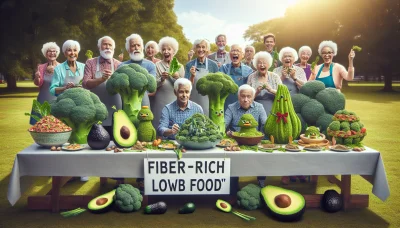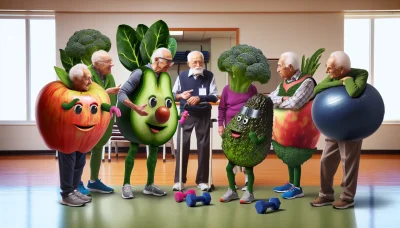Food allowance card for seniors Quiz
Test Your Knowledge
Question of
Understanding Food Allowance Cards for Seniors
Eligibility Criteria for Food Allowance Programs
Seniors looking to benefit from food allowance programs must meet specific eligibility criteria. These criteria ensure that assistance reaches those in genuine need and varies by program. Age, income, and legal residency are the cornerstones of these requirements.
Age Requirements: Generally, individuals must be over a certain age, typically 60 or 65, to qualify for senior food assistance programs. This age threshold aligns with other senior benefits, acknowledging the increased need for support as one ages.
Income Guidelines: Income limits are set to prioritize aid for low-income seniors. These guidelines are often based on federal poverty levels and can vary by state and program, ensuring that resources are allocated to those most financially vulnerable.
Residency and Citizenship Status: Applicants must typically be residents of the state where they're applying and either U.S. citizens or hold eligible non-citizen status. These requirements help manage program resources effectively within each community.
Types of Food Allowance Cards Available
Food allowance cards come in various forms, each designed to cater to the unique needs of seniors. They range from government-issued benefits to cards provided by non-profits and private companies offering discounts. Accessibility and convenience are key features of these cards.
Government-Issued Benefit Cards: These cards are typically part of federal assistance programs like SNAP. They work like debit cards, allowing seniors to purchase food at authorized retailers smoothly and with dignity.
Non-Profit Organization Cards: Many non-profit organizations issue food cards dedicated to senior nutrition support. These may be accepted at local food banks or community centers providing meals or groceries specifically for older adults.
- Private Sector Discount Cards: Some private companies offer discount cards that provide seniors with reduced prices on groceries and dining. While not a direct allowance, these discounts help stretch fixed incomes further.
How to Apply for a Food Allowance Card
The application process for food allowance cards can seem daunting, but understanding the steps involved simplifies the task. Each program has its procedures; however, they commonly require an initial application followed by verification of eligibility.
Application Process Overview: Most programs begin with a standard application form that collects basic personal information, financial details, and evidence of age and residency. This form is the first step in assessing an applicants qualification for assistance.
- Necessary Documentation:
- Gather personal identification such as a driver's license or state ID card.
- Collect financial records including income statements, tax returns, and bank statements.
- Prepare proof of residency like utility bills or lease agreements.
- Contact local government offices or visit their websites for online submissions.
- Inquire at community centers or non-profits about their application processes.
Maximizing Benefits with Your Senior Food Card
Budgeting Tips for Food Shopping
Creating a monthly food budget is paramount for seniors looking to stretch their food card benefits. Start by tracking your spending to establish a baseline, then set realistic goals to stay within your means. Remember, the aim is consistent savings without sacrificing nutrition!
Identifying cost-effective stores can be a game-changer. Compare prices at different supermarkets, local farmers' markets, and bulk stores. Some locations offer senior discounts on certain days, so plan your shopping accordingly to maximize savings!
Utilizing coupons and discounts effectively can slash your grocery bills significantly. Keep an eye out for deals in store circulars, use digital coupon apps, and don't forget that your senior food card may offer additional discounts at participating stores.
Healthy Eating on a Limited Budget
Nutrient-rich foods don't have to break the bank. Opt for whole grains, beans, and lentils which are not only affordable but also packed with essential nutrients. Eggs and canned fish are great low-cost protein sources.
Planning balanced meals is crucial for maintaining good health. Ensure each meal contains a protein source, fruits and vegetables, and whole grains. This approach supports overall wellness and can prevent costly health issues down the line.
Shopping for seasonal produce is both economical and nutritious. Seasonal fruits and vegetables are often fresher, tastier, and cheaper than their out-of-season counterparts. Plus, they add variety to your diet throughout the year!
Understanding the Nutritional Needs of Seniors
Dietary requirements for aging adults shift as metabolism slows down and nutritional needs change. Seniors should focus on nutrient-dense foods that provide vitamins and minerals without too many extra calories. Lean proteins, fiber-rich foods, and calcium sources are key components.
The importance of hydration cannot be overstated for seniors. Water aids in digestion, prevents constipation, and helps manage chronic conditions. Aim for 8 glasses a day unless otherwise directed by a healthcare professional.
- Avoid excessive sodium: Too much salt can lead to hypertension.
- Limited sugar intake: Reducing sugar helps control blood glucose levels.
- Moderate alcohol consumption: Alcohol can interact with medications.
- Careful with caffeine: It can affect sleep patterns and hydration levels.
- Focus on fiber: A high-fiber diet supports digestive health.
Navigating Dietary Restrictions with Food Allowance Cards
Gluten-Free Diets for Seniors
Adopting a gluten-free diet can be a game-changer for seniors with celiac disease or gluten sensitivity. It's not just about cutting out wheat; it involves understanding that gluten can lurk in many processed foods, sauces, and even medications. The transition to gluten-free living can lead to improved digestion, increased energy levels, and a better quality of life.
Finding Gluten-Free Options
Discovering gluten-free alternatives is easier now than ever before! Supermarkets are expanding their ranges, offering everything from bread and pasta to snacks that cater to gluten-free needs. Eating out doesn't have to be a hassle either, with many restaurants providing gluten-free menus or adaptable dishes. Remember, the key is communicationalways inform your server of dietary restrictions!
Reading Labels for Hidden Gluten
Becoming a label detective is crucial when avoiding gluten. It's essential to look beyond obvious sources like bread and cereals and check for hidden gluten in condiments, soups, and even beverages. Watch out for terms like 'malt flavoring' or 'modified food starch,' which can indicate the presence of gluten.
Gluten-Free Meal Planning
Planning meals ahead of time can transform the gluten-free diet from daunting to doable. By prepping meals at home, seniors gain control over their ingredients and avoid accidental exposure to gluten. Plus, batch cooking and freezing meals ensures there's always something safe and delicious on hand!
Managing Diabetes with a Controlled Diet
Carbohydrate Counting Basics
For those managing diabetes, mastering carbohydrate counting is paramount. Carbohydrates directly affect blood sugar levels, so understanding which foods contain carbs and how much you're consuming can help maintain balance. This method provides flexibility in food choices while still controlling diabetes effectively.
Sugar-Free and Low-Glycemic Foods
Sugar-free does not mean carb-free! When selecting sugar-free items, it's imperative to assess the total carbohydrate content since other ingredients may still impact blood sugar levels. Opting for low-glycemic foods that have a slower effect on blood glucose can also help stabilize energy throughout the day.
Incorporating Fiber into Meals
Fiber is your friend when it comes to diabetes management! High-fiber foods not only aid digestion but also slow down the absorption of sugars into the bloodstream, reducing spikes in blood sugar levels. From vegetables and fruits to whole grains and legumesthere are countless tasty ways to boost fiber intake.
Heart-Healthy Eating Strategies
Low-Sodium Food Choices
A low-sodium diet is vital for heart health as it helps manage blood pressure levels. Fresh foods are generally lower in sodium compared to their canned or processed counterparts. Cooking at home allows for greater control over salt contenta simple yet effective way to care for your heart!
The Role of Omega-3 Fatty Acids
The benefits of omega-3 fatty acids cannot be overstatedthey're essential for maintaining heart health! Found abundantly in fish like salmon and mackerel as well as flaxseeds and walnuts, these nutrients help reduce inflammation and lower the risk of chronic diseases associated with aging.
- Avoid trans fats found in many baked goodsthey're detrimental to heart health.
- Choose lean proteins such as poultry or plant-based options over red meats.
- Select whole grains instead of refined ones to keep your heart running smoothly.
- Moderation is keyindulge occasionally but focus on nutrient-rich foods as staples.
Balancing Fats in Your Diet
Fats are not the enemyif you choose wisely! Unsaturated fats found in avocados, nuts, and olive oil are beneficial for heart health. Balancing these with limited intake of saturated fats from animal products can lead to an overall healthier diet and a happier heart.
Exploring Cultural Diets with Food Allowance Cards
Mediterranean Diet for Longevity and Health
The Mediterranean diet is widely acclaimed for its health benefits, particularly in promoting longevity and reducing the risk of chronic diseases. This eating pattern is inspired by the traditional foods of countries bordering the Mediterranean Sea, emphasizing whole grains, fruits, vegetables, legumes, and nuts.
Studies have shown that adherence to this diet correlates with a lower incidence of heart disease and may enhance cognitive function. The diet's richness in antioxidants and anti-inflammatory properties makes it a top choice for those seeking a healthy lifestyle.
Key Components of the Mediterranean Diet
The core elements of the Mediterranean diet include a high intake of plant-based foods and moderate consumption of dairy products. Fresh produce is not just an accompaniment but the main feature on the plate, providing essential vitamins, minerals, and fiber.
Additionally, this diet minimizes red meat consumption while highlighting fish and poultry as primary protein sources. The integration of these components fosters balanced nutrition that supports overall well-being.
Olive Oil and Healthy Fats
Olive oil stands as the cornerstone fat source within the Mediterranean diet, revered for its monounsaturated fats that are heart-healthy. It replaces butter and other saturated fats, thereby contributing to improved cholesterol levels.
The liberal use of olive oil in cooking and as a dressing enhances flavors while conferring nutritional benefits. Its role in the diet is so central that it's often referred to as "liquid gold" within culinary circles.
Incorporating Seafood and Legumes
Seafood is another pillar of this dietary approach, recommended at least twice a week to provide omega-3 fatty acids crucial for brain health. The diversity of seafood options allows for varied meal planning that can suit any palate.
Legumes like beans, lentils, and chickpeas are also integral to the Mediterranean diet. They're excellent protein substitutes for meat, packed with fiber that aids digestion and helps maintain blood sugar levels.
Traditional Asian Dietary Practices
The Asian diet encompasses an array of culinary traditions from various countries across the continent. It's characterized by balance, variety, and moderation with rice or noodles often serving as staple components of meals.
This diet has been associated with lower rates of obesity and chronic diseases in Asian populations. Its focus on fresh ingredients cooked in healthful ways contributes to its nutritional value.
Emphasis on Rice and Noodles
Rice is more than just a side dish in Asian cuisine; it's a versatile foundation for meals throughout China, Japan, Korea, and Southeast Asia. Similarly, noodles come in many forms from wheat-based to rice-based each bringing unique textures to dishes.
In both cases, these starches serve as energy sources that complement other components like vegetables or proteins rather than overpowering them.
Variety of Vegetables and Fermented Foods
Vibrant vegetables play a starring role in Asian diets. Not only do they add color to dishes but also supply essential nutrients without excessive calories. From leafy greens to root vegetables each offers distinctive health benefits.
- *Fermented foods such as kimchi or miso are staples that contribute probiotics aiding digestion. *Vegetable-rich diets support immune function through their vitamin content. *Regular consumption of a diverse range of vegetables can reduce disease risk factors. *Inclusion of fermented foods enhances gut health which is linked to overall wellness.
Lean Proteins and Herbal Teas
Protein sources in Asian diets tend toward lean options like fish, tofu, and poultry. These choices are lower in saturated fat compared to red meats but still offer ample protein content necessary for muscle maintenance and repair.
Herbal teas accompany meals frequently within Asian cultures. Not only do they aid digestion but also introduce additional antioxidants into one's diet all without added sugars found in many Western beverages.
Benefits of Plant-Based Diets for Seniors
As individuals age, their nutritional needs change; plant-based diets offer numerous benefits tailored to senior health requirements. These diets are rich in nutrients yet low in calories which can help manage weight effectivelya vital factor for seniors' mobility and joint health.
Nutrient Density in Vegetables and Fruits
Fruits and vegetables are nutrient powerhouses packed with vitamins A & C alongside folateessential for immune function among older adults. Their natural antioxidant properties combat cellular damage related to aging processes too!
Whole Grains and Fiber Intake
Adequate fiber intake is crucial for digestive regularitya common concern among seniors. Whole grains offer a hearty source along with essential B vitamins contributing to energy metabolism within cells.
Plant Proteins AND LEGUMES
Introducing more plant proteins such as lentils beans peas into seniors' diets can support muscle mass without excessive saturated fat intake associated with some animal proteins these sources also tend towards being more cost-effective an important consideration given fixed incomes during retirement years."
Seasonal Eating with Food Allowance Cards
Spring: Fresh Start with Seasonal Produce
Leafy Greens and Their Benefits
Spring heralds the arrival of tender, leafy greens like spinach, kale, and arugula. Packed with vitamins A, C, and K, they're a powerhouse of nutrition for seniors. Incorporating these greens into daily meals can help maintain eye health, support immune function, and promote bone strength.
Spring Fruits and Their Nutritional Value
Fruits such as strawberries and apricots bloom into season, offering sweet flavors and vital nutrients. These springtime treasures are rich in antioxidants and dietary fiber which aid in digestion and combat inflammation. They're perfect for seniors looking to enhance their diet with natural sweetness.
Light and Refreshing Meal Ideas
Food allowance cards can be wisely used to purchase ingredients for zesty salads and smoothies. Utilizing spring produce in meals not only boosts nutrient intake but also adds variety to the diet. These light options are ideal for seniors as they're easy to prepare and digest.
Summer: Hydration and Light Meals
Summer Vegetables for Hydration
Cucumbers, tomatoes, and bell peppers are summer staples that help keep seniors hydrated during hot months. These veggies have high water content and essential electrolytes that replenish fluids lost through sweat. Including them in the diet can prevent dehydration-related issues.
Cold Soups and Salads Recipes
Gazpacho or chilled cucumber soup can be refreshing meal choices that maximize seasonal produce. Food allowance cards are perfect for sourcing fresh ingredients to create these cold dishes. They are not only hydrating but also easy on the stomach, making them summer-friendly for seniors.
- Mistake: Skipping meals Ensure regular intake of nutrients by maintaining meal schedules.
- Tip: Use herbs for flavor Enhance dishes without extra salt or sugar by using fresh herbs.
- Mistake: Overcooking vegetables Preserve nutrients by steaming or grilling veggies instead of boiling them extensively.
- Tip: Embrace variety Keep meals interesting by experimenting with different fruits and vegetables throughout the season.
- Mistake: Ignoring hydration cues Drink plenty of fluids throughout the day, even if not feeling thirsty.
- Tip: Plan ahead Use food allowance cards strategically to buy in-season produce in bulk when it's freshest and most affordable.
Fruit-Based Snacks for Nutrition and Cooling Effect
Fruit-based snacks like frozen grapes or melon cubes offer a nutritional boost while cooling down the body. Seniors can use food allowance cards to stock up on these summer fruits. They provide quick energy, essential minerals, and help regulate body temperature during heatwaves.
Fall and Winter: Warming Foods for Seniors
Root Vegetables and Squashes
In the cooler months, root vegetables become a dietary staple due to their storage longevity and dense nutritional content. Carrots, beets, and squashes are full of vitamins that support senior health through the fall and winter seasons. These foods can be easily roasted or pureed into soups for comforting warmth.
Hearty Stews and Soups Recipes
Cooking up hearty stews and soups is a fantastic way to utilize seasonal produce like potatoes, turnips, and parsnips. These recipes often require minimal effort but deliver maximum flavor and nutrition. Stews are particularly beneficial for seniors looking for satisfying meals that are gentle on digestion.
Citrus Fruits for Immune Support
Citrus fruits come into season just when seniors need an extra boost of vitamin C to ward off colds. Oranges, grapefruits, and lemons can be easily incorporated into daily diets with the help of food allowance cards. Their immune-supporting properties are crucial during colder months when staying healthy is paramount.
Cooking and Meal Preparation for Seniors with Food Allowance Cards
Easy and Nutritious Recipes for One or Two People
Preparing meals for one or two can be a delightful and straightforward task! With food allowance cards, seniors have the freedom to purchase fresh ingredients to create wholesome dishes. Single-serving recipes ensure that there's no waste, while still providing the necessary nutrients. It's all about picking the right recipe that's both satisfying and simple to make.
Single-Serving Meal Ideas are a game-changer. They're perfectly portioned, reducing the hassle of leftovers. Imagine whipping up a quick stir-fry with your favorite vegetables, a piece of lean protein, and some brown rice. Or consider a hearty soup that warms the soulone pot can offer several comforting meals!
When it comes to Batch Cooking and Storage Tips , think efficiency! Cooking in batches saves time and energy. Freeze portions in labeled containers for later enjoyment. This approach is not only convenient but also ensures that you have healthy, homemade meals on hand at all times.
Time-Saving Cooking Techniques are your best friend in the kitchen. Use pressure cookers or slow cookers to your advantagethey do the work while you relax. Planning meals ahead and prepping ingredients before cooking can also cut down on kitchen time dramatically.
Adapting Recipes to Meet Dietary Needs
Substituting Ingredients for Healthier Options is easier than you might think. Swap out white pasta for whole grain varieties or use Greek yogurt in place of sour cream for a protein-packed alternative. These small changes can make a significant impact on health without sacrificing taste.
Texture Modifications for Easier Consumption can cater to various needs without compromising on flavor. Pureeing soups or mashing vegetables allows those with chewing difficulties to enjoy their meals comfortably. It's all about adapting textures to individual preferences while maintaining nutritional value.
- Flavor Enhancements Without Added Salt or Sugar:
- Increase herbs and spices like basil, oregano, or cinnamon to boost flavor naturally.
- Add citrus zest or vinegar for a tangy kick that doesn't rely on salt.
- Rely on the natural sweetness of fruits or root vegetables instead of adding sugar.
- Roasting vegetables caramelizes their natural sugars, enhancing their taste.
- Select aromatic vegetables such as onions and garlic to deepen flavors in any dish.
Kitchen Safety and Ergonomic Cooking Tools
Preventing Falls and Injuries in the Kitchen is crucial for safety. Ensure that walkways are clear and lighting is adequate. Non-slip mats can provide stability while standing and working at counters. Keep frequently used items within easy reach to avoid overstretching or bending too much.
Ergonomic Utensils for Arthritis Management can be life-changing. Look for tools with large, soft grips that are easier on the joints. Electric can openers and ergonomic knives reduce strain during food prep, making cooking an enjoyable experience rather than a painful one.
Safe Food Handling and Storage Practices are essential to prevent foodborne illnesses. Always wash hands before handling food, keep raw meats separate from other groceries, and store leftovers promptly at safe temperatures. Regularly clean your refrigerator and check expiration dates to ensure freshness!
Community Resources and Support for Senior Nutrition
Local Food Banks and Pantry Programs
Access to nutritious food is a cornerstone of good health, especially for seniors. Local food banks and pantry programs are lifelines, offering a variety of foods tailored to older adults' dietary needs. These programs are designed to alleviate food insecurity among seniors, ensuring they have regular access to healthy meals.
Finding a Local Food Bank: Locating a food bank in your area is the first step towards receiving assistance. Many organizations provide online directories to help seniors find the nearest food assistance services. Libraries and community centers can also be excellent resources for this information.
Understanding the Distribution Schedule: Once you've found a local food bank, it's crucial to understand their distribution schedule. Most food banks operate on specific days and hours, so familiarizing yourself with this timetable ensures you won't miss out on valuable support.
Volunteering and Community Involvement: Beyond receiving aid, volunteering at local food banks can be immensely rewarding. It's an opportunity for seniors to give back, stay active, and foster community connections. Plus, volunteers often gain insight into additional resources and services available.
Senior Centers and Meal Service Programs
Senior centers play a pivotal role in providing nutritional support to the elderly. They offer meal service programs that cater to the dietary requirements of older adults, helping them maintain a balanced diet without the stress of meal preparation.
Congregate Meal Benefits: Congregate meals at senior centers are more than just about food; they offer nutritional benefits along with opportunities for social interaction. Seniors can enjoy hot, wholesome meals while engaging with their peers in a communal setting.
Home-Delivered Meals for Homebound Seniors: For those unable to leave their homes, many senior centers coordinate home-delivered meal services. These programs ensure that even the most isolated seniors receive nutritious meals directly to their doorsteps.
- Social Aspects of Community Dining: Participating in community dining can significantly enhance a senior's quality of life by combating loneliness and isolation.
- Nutritional Guidance: Senior centers often provide access to nutritionists who can offer personalized dietary advice catering to specific health needs.
- Variety in Cuisine: Regularly changing menus keep meals interesting and encourage seniors to try new dishes within a nutritious framework.
Educational Workshops on Nutrition and Budgeting
Educational workshops aimed at seniors provide valuable knowledge on managing nutrition on a fixed income. These workshops empower seniors with skills to make informed choices about their diet and finances.
Cooking Classes for Seniors: Cooking classes specifically designed for seniors can revolutionize how they approach meal preparation. These classes focus on creating simple, nutritious meals that cater to common dietary restrictions found in older adults.
Financial Management Seminars: Financial seminars address the unique budgeting challenges faced by seniors. Learning how to stretch dollars while maintaining a healthy diet is an invaluable skill that these seminars promote.
Nutrition Education Sessions: Understanding the basics of nutrition is essential for seniors. Educational sessions cover topics such as reading nutrition labels, understanding dietary needs, and making smart food choices that support long-term health.
Staying Informed About Changes in Senior Food Assistance Programs
Keeping Up with Policy Changes
It's absolutely crucial to stay on top of policy changes that affect senior food assistance programs. These changes can impact eligibility, benefits, and access to services. Government agencies frequently update their policies, so active engagement is key to understanding your rights and benefits.
To ensure you're receiving the latest information, bookmark and visit official government websites regularly. These sites are treasure troves of up-to-date policy details and often provide comprehensive FAQs that address common concerns and changes in the programs.
Subscribing to newsletters from senior advocacy groups is another smart move. These organizations have their fingers on the pulse of legislative changes and can provide insider insights not readily available elsewhere. They also offer practical advice on navigating any new system updates.
Don't underestimate the value of community meetings and information sessions. Local gatherings are not only informative but also offer opportunities to connect with peers who may share additional tips or personal experiences regarding recent program changes.
Technology Tools to Manage Your Food Allowance Card
Get excited about technology tools that make managing your food allowance card a breeze! Mobile apps specifically designed for tracking expenses can transform your smartphone into a powerful budgeting assistant, helping you monitor your spending patterns effortlessly.
Online portals for benefit management are another fantastic resource. They allow you to check balances, review transactions, and plan your grocery shopping around your remaining benefits all from the comfort of your home!
Set up automated alerts for balance updates and expiry dates so you never miss out on using your benefits. These alerts can often be customized to fit your preferences, ensuring you receive notifications exactly when you need them.
Advocacy and Feedback Channels
Your voice matters! Providing feedback to program administrators is a powerful way to advocate for yourself and others in the community. Whether it's praise for what's working well or constructive criticism for what could improve, your input is invaluable for shaping better programs.
Becoming a part of senior rights organizations is not just empoweringit's also a proactive step towards safeguarding your interests. These groups work tirelessly to represent seniors at various levels of government and ensure that their voices are heard in policy-making discussions.
- Educate Yourself: Understand the details of current programs and proposed changes.
- Stay Organized: Keep records of all communications and documents related to your advocacy efforts.
- Be Persistent: Change takes time; don't be discouraged by setbacks.
- Build Alliances: Connect with others who share your concerns to amplify your voice.
- Use Multiple Channels: Engage through letters, calls, social media, and public forums.
- Maintain Respectful Discourse: Even when disagreeing, remain respectful for more productive dialogue.
- Share Personal Stories: Real-life examples often resonate more than abstract arguments.
- Vary Your Tactics: If one approach isn't working, try another way to convey your message.
In addition to joining groups, participating in surveys and studies related to senior food assistance can contribute valuable data that helps inform future decisions. Your experiences provide a unique perspective that can lead to meaningful improvements in program design and delivery.












